towing BMW X5 3.0I 2003 Owners Manual
[x] Cancel search | Manufacturer: BMW, Model Year: 2003, Model line: X5 3.0I, Model: BMW X5 3.0I 2003Pages: 183, PDF Size: 2.31 MB
Page 6 of 183
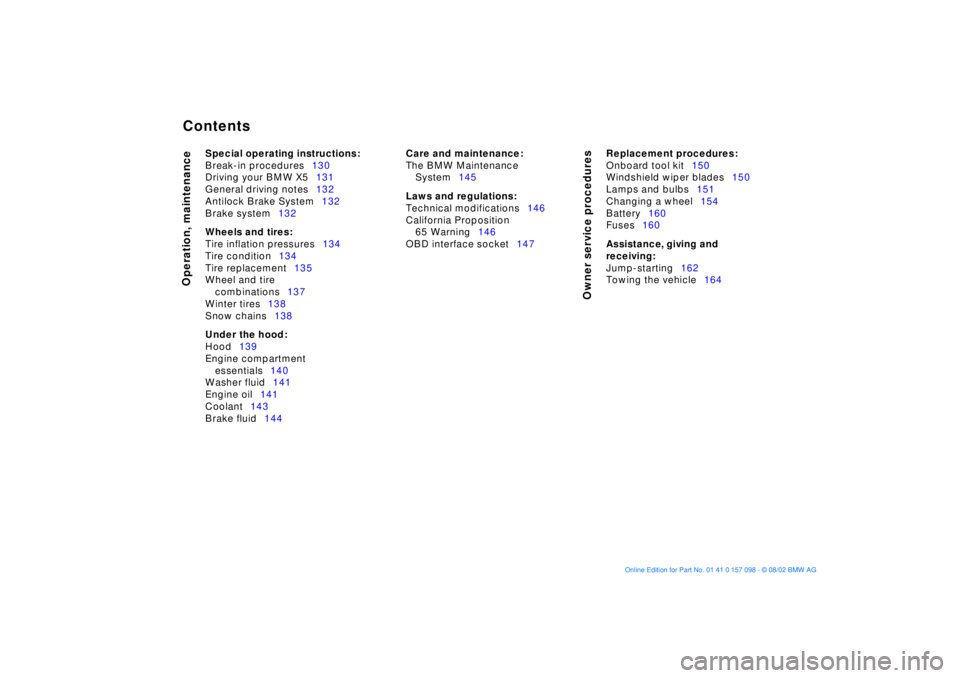
Contents
Operation, maintenance
Owner service procedures
Special operating instructions:
Break-in procedures130
Driving your BMW X5131
General driving notes132
Antilock Brake System132
Brake system132
Wheels and tires:
Tire inflation pressures134
Tire condition134
Tire replacement135
Wheel and tire
combinations137
Winter tires138
Snow chains138
Under the hood:
Hood139
Engine compartment
essentials140
Washer fluid141
Engine oil141
Coolant143
Brake fluid144
Care and maintenance:
The BMW Maintenance
System145
Laws and regulations:
Technical modifications146
California Proposition
65 Warning146
OBD interface socket147
Replacement procedures:
Onboard tool kit150
Windshield wiper blades150
Lamps and bulbs151
Changing a wheel154
Battery160
Fuses160
Assistance, giving and
receiving:
Jump-starting162
Towing the vehicle164
Page 38 of 183
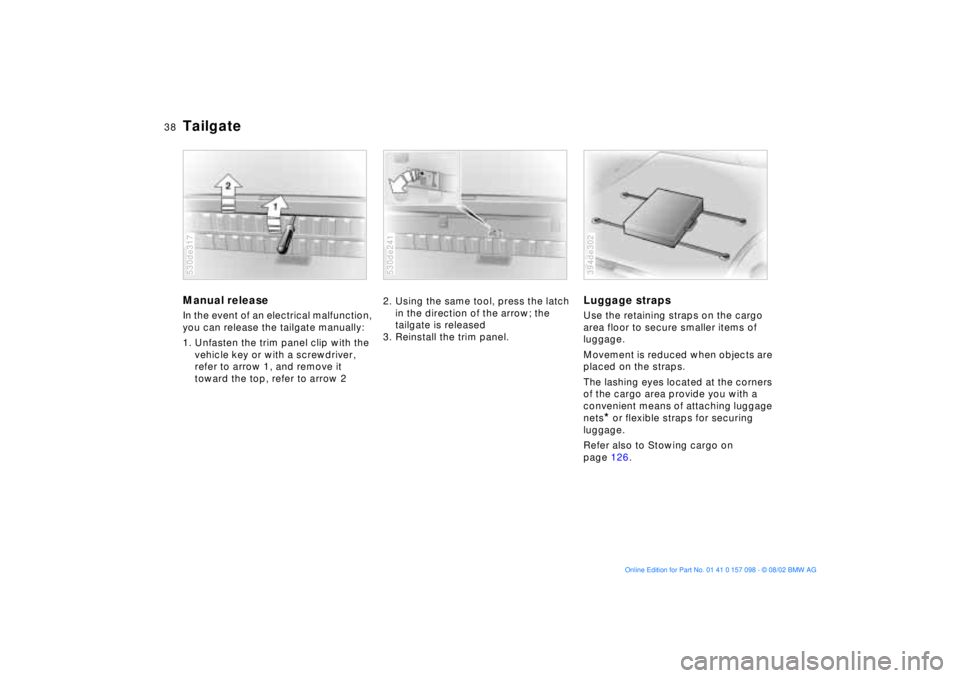
38n
TailgateManual release In the event of an electrical malfunction,
you can release the tailgate manually:
1. Unfasten the trim panel clip with the
vehicle key or with a screwdriver,
refer to arrow 1, and remove it
toward the top, refer to arrow 2530de317
2. Using the same tool, press the latch
in the direction of the arrow; the
tailgate is released
3. Reinstall the trim panel. 530de241
Luggage strapsUse the retaining straps on the cargo
area floor to secure smaller items of
luggage.
Movement is reduced when objects are
placed on the straps.
The lashing eyes located at the corners
of the cargo area provide you with a
convenient means of attaching luggage
nets
* or flexible straps for securing
luggage.
Refer also to Stowing cargo on
page 126.
394de302
Page 67 of 183
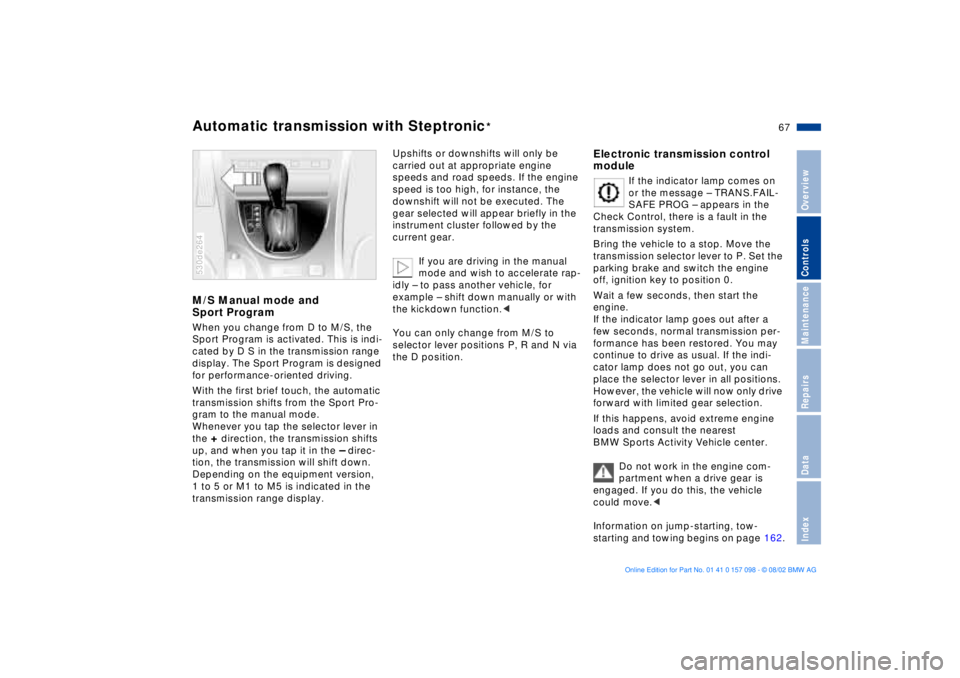
67n
OverviewControlsMaintenanceRepairsDataIndex
Automatic transmission with Steptronic
*
M/S Manual mode and
Sport Program When you change from D to M/S, the
Sport Program is activated. This is indi-
cated by D S in the transmission range
display. The Sport Program is designed
for performance-oriented driving.
With the first brief touch, the automatic
transmission shifts from the Sport Pro-
gram to the manual mode.
Whenever you tap the selector lever in
the
+ direction, the transmission shifts
up, and when you tap it in the
Ð direc-
tion, the transmission will shift down.
Depending on the equipment version,
1 to 5 or M1 to M5 is indicated in the
transmission range display.
530de264
Upshifts or downshifts will only be
carried out at appropriate engine
speeds and road speeds. If the engine
speed is too high, for instance, the
downshift will not be executed. The
gear selected will appear briefly in the
instrument cluster followed by the
current gear.
If you are driving in the manual
mode and wish to accelerate rap-
idly Ð to pass another vehicle, for
example Ð shift down manually or with
the kickdown function.<
You can only change from M/S to
selector lever positions P, R and N via
the D position.
Electronic transmission control
module
If the indicator lamp comes on
or the message Ð TRANS.FAIL-
SAFE PROG Ð appears in the
Check Control, there is a fault in the
transmission system.
Bring the vehicle to a stop. Move the
transmission selector lever to P. Set the
parking brake and switch the engine
off, ignition key to position 0.
Wait a few seconds, then start the
engine.
If the indicator lamp goes out after a
few seconds, normal transmission per-
formance has been restored. You may
continue to drive as usual. If the indi-
cator lamp does not go out, you can
place the selector lever in all positions.
However, the vehicle will now only drive
forward with limited gear selection.
If this happens, avoid extreme engine
loads and consult the nearest
BMW Sports Activity Vehicle center.
Do not work in the engine com-
partment when a drive gear is
engaged. If you do this, the vehicle
could move.<
Information on jump-starting, tow-
starting and towing begins on page 162.
Page 94 of 183
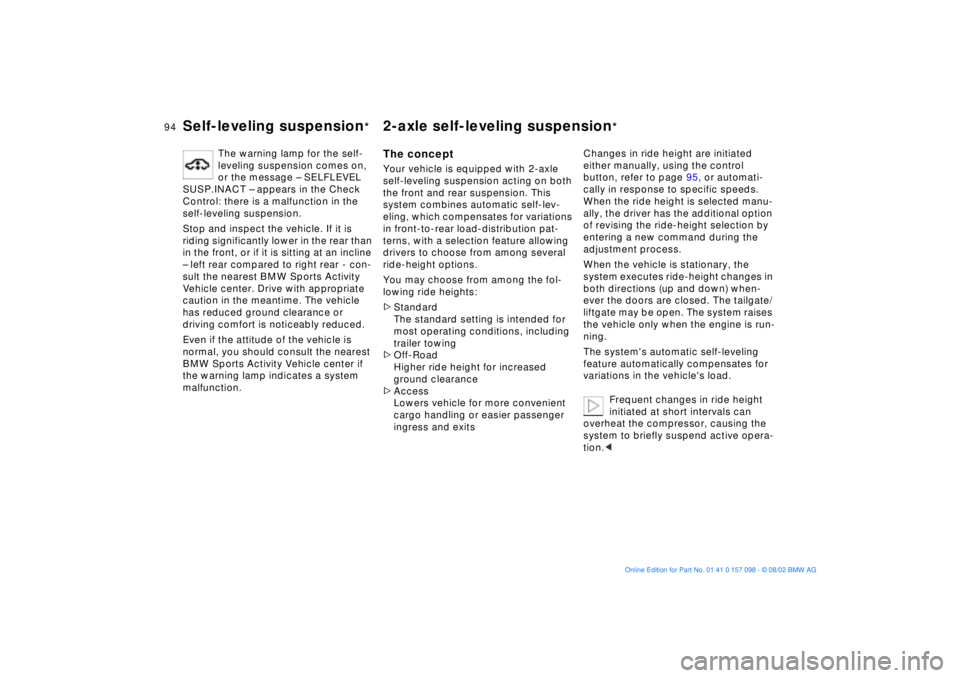
94n
Self-leveling suspension
*
2-axle self-leveling suspension
*
The warning lamp for the self-
leveling suspension comes on,
or the message Ð SELFLEVEL
SUSP.INACT Ð appears in the Check
Control: there is a malfunction in the
self-leveling suspension.
Stop and inspect the vehicle. If it is
riding significantly lower in the rear than
in the front, or if it is sitting at an incline
Ð left rear compared to right rear - con-
sult the nearest BMW Sports Activity
Vehicle center. Drive with appropriate
caution in the meantime. The vehicle
has reduced ground clearance or
driving comfort is noticeably reduced.
Even if the attitude of the vehicle is
normal, you should consult the nearest
BMW Sports Activity Vehicle center if
the warning lamp indicates a system
malfunction.
The conceptYour vehicle is equipped with 2-axle
self-leveling suspension acting on both
the front and rear suspension. This
system combines automatic self-lev-
eling, which compensates for variations
in front-to-rear load-distribution pat-
terns, with a selection feature allowing
drivers to choose from among several
ride-height options.
You may choose from among the fol-
lowing ride heights:
>Standard
The standard setting is intended for
most operating conditions, including
trailer towing
>Off-Road
Higher ride height for increased
ground clearance
>Access
Lowers vehicle for more convenient
cargo handling or easier passenger
ingress and exitsChanges in ride height are initiated
either manually, using the control
button, refer to page 95, or automati-
cally in response to specific speeds.
When the ride height is selected manu-
ally, the driver has the additional option
of revising the ride-height selection by
entering a new command during the
adjustment process.
When the vehicle is stationary, the
system executes ride-height changes in
both directions (up and down) when-
ever the doors are closed. The tailgate/
liftgate may be open. The system raises
the vehicle only when the engine is run-
ning.
The system's automatic self-leveling
feature automatically compensates for
variations in the vehicle's load.
Frequent changes in ride height
initiated at short intervals can
overheat the compressor, causing the
system to briefly suspend active opera-
tion.<
Page 126 of 183

126n
Cargo loadingStowing cargo >Position heavy cargo as far forward
as possible Ð directly behind the
backrests Ð and as low as possible
>Cover sharp edges and corners
>Do not pile objects higher than the
top edge of the backrest
>Fasten the partition net, refer to
page 122, and ensure that carried
items cannot pass through the parti-
tion net
>If you are transporting very heavy
loads when the rear seat is not occu-
pied, secure the outer safety belts in
the opposite buckles. 530de032
Securing the load >Secure smaller, light pieces with the
retaining straps or a luggage net
*, or
use elastic straps, refer to page 38
>For large, heavy pieces, see your
BMW Sports Activity Vehicle center
for load-securing devices
*. The
lashing eyes provided at the corners
of the cargo area serve for mounting
these load-securing devices
>Read and comply with the informa-
tion enclosed with the load-securing
devices.
530us090
Always position and secure the
load correctly. If you do not, it can
endanger the passengers, e.g. simply
during braking or evasive maneuvers.
Do not exceed the permissible gross
vehicle weight and the permissible axle
loads, refer to page 170. If you do, the
operating safety of the vehicle is no
longer ensured and you are in violation
of the law.
Do not carry hard or heavy objects
unsecured in the passenger compart-
ment. If you do so, they may be pro-
jected through the air, e.g. simply
during braking and evasive maneuvers,
thus endangering vehicle occupants.<
Page 130 of 183

130n
Break-in proceduresTo ensure that your vehicle provides
maximum economy throughout a long
service life, we request that you
observe the following instructions: Engine and differential Up to 1,200 miles/2,000 km:
Drive at varying engine speeds and
road speeds, but do not exceed
4,500 rpm and the following road
speeds during this initial period:
6-cylinder engines: 100 mph/160 km/h
8-cylinder engines: 106 mph/170 km/h
Obey your local and state maximum
speed limits.
Refrain from using full throttle and avoid
pressing the accelerator beyond the
kickdown point.
Once you have driven 1,200 miles/
2,000 km, engine and vehicle speeds
can gradually be increased.
You should also comply with these
break-in procedures should the engine
or one of the differentials be replaced
later in the course of the vehicle's ser-
vice life.
TiresDue to technical factors associated
with their manufacture, tires do not
achieve their full traction potential until
an initial break-in period has elapsed.
For this reason, drive with extra care
during the initial 200 miles/300 km.
Obey your local and state maximum
speed limits.
When the vehicle is operated on
wet or slushy roads, a wedge of
water may form between the tire and
the road surface. This phenomenon is
referred to as aquaplaning, or hydro-
planing, and can lead to partial or com-
plete loss of traction, vehicle control
and braking effectiveness. Reduce your
speed on wet roads.<
Brake systemApprox. 300 miles/500 km must elapse
before the brake pads and rotors
achieve the optimal pad-surface and
wear patterns required for trouble-free
operation and long service life later on.
To break in the separate parking brake
drums, apply the parking brake lightly
when coasting to a standstill at a traffic
signal, for instance, provided that traffic
conditions allow you to do so.
To avoid corrosion, repeat this proce-
dure from time to time.
The brake lamps do not light up
when the parking brake is applied.
Vacuum for the brake system servo unit
on your BMW is available only when the
engine is running. When you move the
vehicle with the engine switched off Ð
when towing, for instance Ð substan-
tially higher levels of pedal force will be
required to brake the vehicle.<
Page 164 of 183
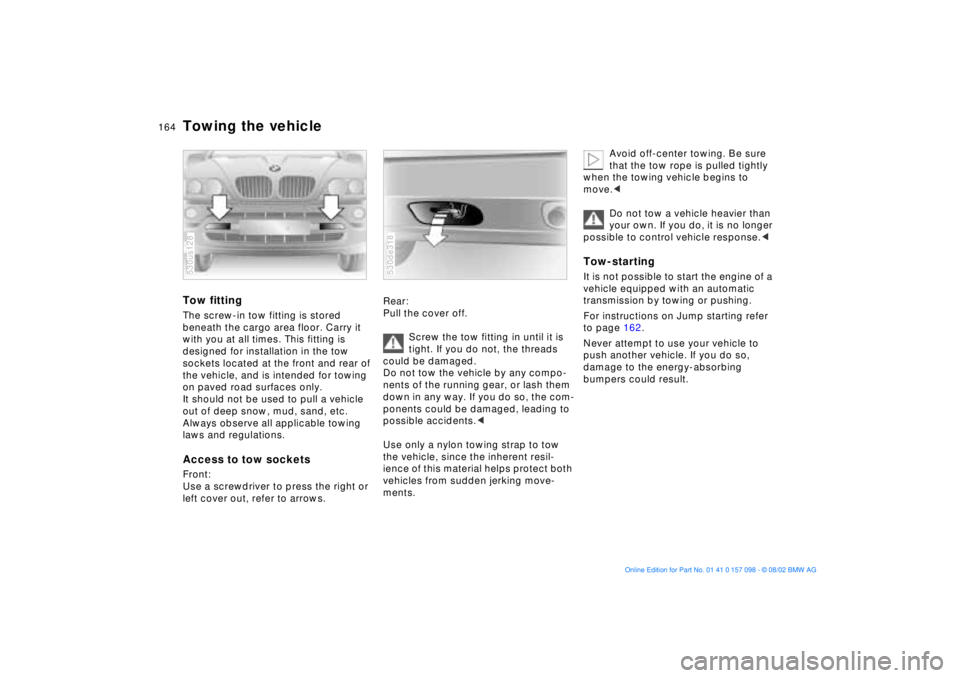
164n
Towing the vehicle Tow fittingThe screw-in tow fitting is stored
beneath the cargo area floor. Carry it
with you at all times. This fitting is
designed for installation in the tow
sockets located at the front and rear of
the vehicle, and is intended for towing
on paved road surfaces only.
It should not be used to pull a vehicle
out of deep snow, mud, sand, etc.
Always observe all applicable towing
laws and regulations. Access to tow sockets Front:
Use a screwdriver to press the right or
left cover out, refer to arrows.530us128
Rear:
Pull the cover off.
Screw the tow fitting in until it is
tight. If you do not, the threads
could be damaged.
Do not tow the vehicle by any compo-
nents of the running gear, or lash them
down in any way. If you do so, the com-
ponents could be damaged, leading to
possible accidents.<
Use only a nylon towing strap to tow
the vehicle, since the inherent resil-
ience of this material helps protect both
vehicles from sudden jerking move-
ments. 530de318
Avoid off-center towing. Be sure
that the tow rope is pulled tightly
when the towing vehicle begins to
move.<
Do not tow a vehicle heavier than
your own. If you do, it is no longer
possible to control vehicle response.<
Tow-startingIt is not possible to start the engine of a
vehicle equipped with an automatic
transmission by towing or pushing.
For instructions on Jump starting refer
to page 162.
Never attempt to use your vehicle to
push another vehicle. If you do so,
damage to the energy-absorbing
bumpers could result.
Page 165 of 183
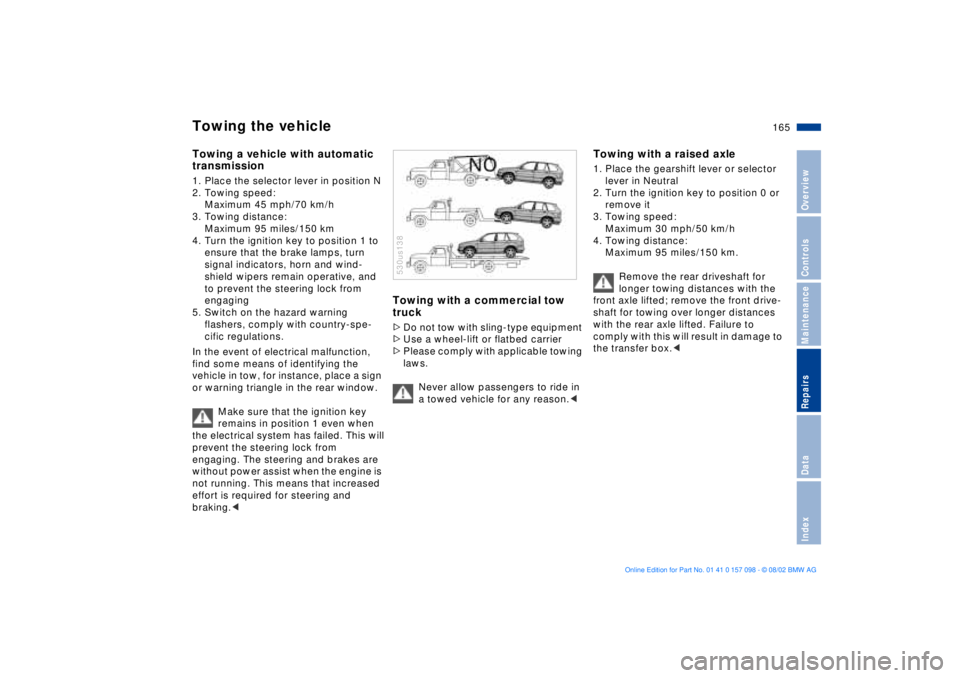
165n
OverviewControlsMaintenanceRepairsDataIndex
Towing the vehicle Towing a vehicle with automatic
transmission1. Place the selector lever in position N
2. Towing speed:
Maximum 45 mph/70 km/h
3. Towing distance:
Maximum 95 miles/150 km
4. Turn the ignition key to position 1 to
ensure that the brake lamps, turn
signal indicators, horn and wind-
shield wipers remain operative, and
to prevent the steering lock from
engaging
5. Switch on the hazard warning
flashers, comply with country-spe-
cific regulations.
In the event of electrical malfunction,
find some means of identifying the
vehicle in tow, for instance, place a sign
or warning triangle in the rear window.
Make sure that the ignition key
remains in position 1 even when
the electrical system has failed. This will
prevent the steering lock from
engaging. The steering and brakes are
without power assist when the engine is
not running. This means that increased
effort is required for steering and
braking.<
Towing with a commercial tow
truck >Do not tow with sling-type equipment
>Use a wheel-lift or flatbed carrier
>Please comply with applicable towing
laws.
Never allow passengers to ride in
a towed vehicle for any reason.< 530us138
Towing with a raised axle 1. Place the gearshift lever or selector
lever in Neutral
2. Turn the ignition key to position 0 or
remove it
3. Towing speed:
Maximum 30 mph/50 km/h
4. Towing distance:
Maximum 95 miles/150 km.
Remove the rear driveshaft for
longer towing distances with the
front axle lifted; remove the front drive-
shaft for towing over longer distances
with the rear axle lifted. Failure to
comply with this will result in damage to
the transfer box.<
Page 176 of 183
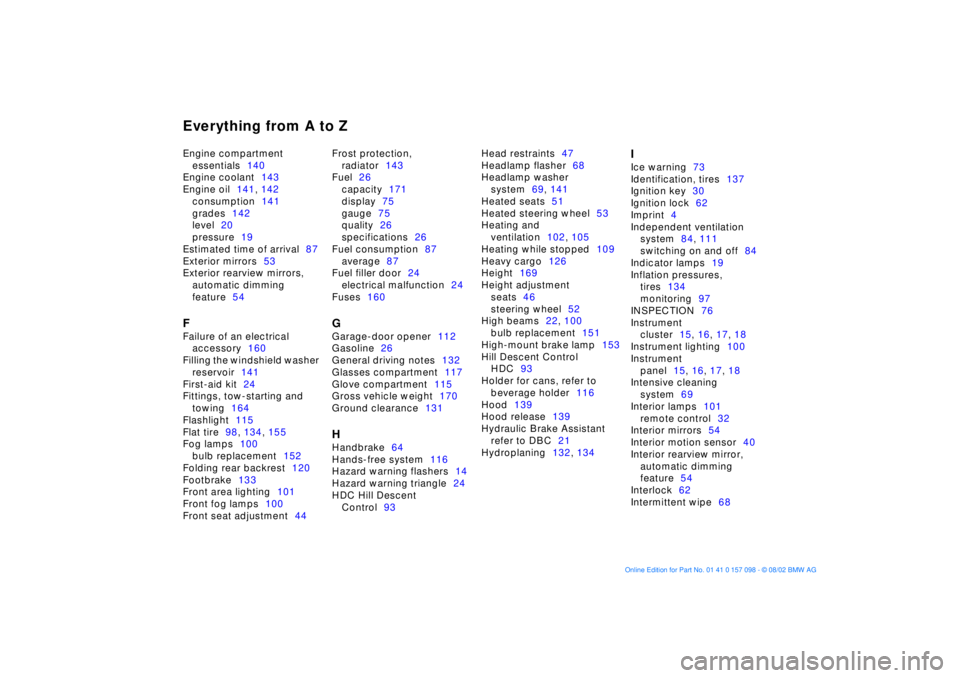
Everything from A to ZEngine compartment
essentials140
Engine coolant143
Engine oil141, 142
consumption141
grades142
level20
pressure19
Estimated time of arrival87
Exterior mirrors53
Exterior rearview mirrors,
automatic dimming
feature54FFailure of an electrical
accessory160
Filling the windshield washer
reservoir141
First-aid kit24
Fittings, tow-starting and
towing164
Flashlight115
Flat tire98, 134, 155
Fog lamps100
bulb replacement152
Folding rear backrest120
Footbrake133
Front area lighting101
Front fog lamps100
Front seat adjustment44Frost protection,
radiator143
Fuel26
capacity171
display75
gauge75
quality26
specifications26
Fuel consumption87
average87
Fuel filler door24
electrical malfunction24
Fuses160
GGarage-door opener112
Gasoline26
General driving notes132
Glasses compartment117
Glove compartment115
Gross vehicle weight170
Ground clearance131HHandbrake64
Hands-free system116
Hazard warning flashers14
Hazard warning triangle24
HDC Hill Descent
Control93Head restraints47
Headlamp flasher68
Headlamp washer
system69, 141
Heated seats51
Heated steering wheel53
Heating and
ventilation102, 105
Heating while stopped109
Heavy cargo126
Height169
Height adjustment
seats46
steering wheel52
High beams22, 100
bulb replacement151
High-mount brake lamp153
Hill Descent Control
HDC93
Holder for cans, refer to
beverage holder116
Hood139
Hood release139
Hydraulic Brake Assistant
refer to DBC21
Hydroplaning132, 134
IIce warning73
Identification, tires137
Ignition key30
Ignition lock62
Imprint4
Independent ventilation
system84, 111
switching on and off84
Indicator lamps19
Inflation pressures,
tires134
monitoring97
INSPECTION76
Instrument
cluster15, 16, 17, 18
Instrument lighting100
Instrument
panel15, 16, 17, 18
Intensive cleaning
system69
Interior lamps101
remote control32
Interior mirrors54
Interior motion sensor40
Interior rearview mirror,
automatic dimming
feature54
Interlock62
Intermittent wipe68
Page 179 of 183
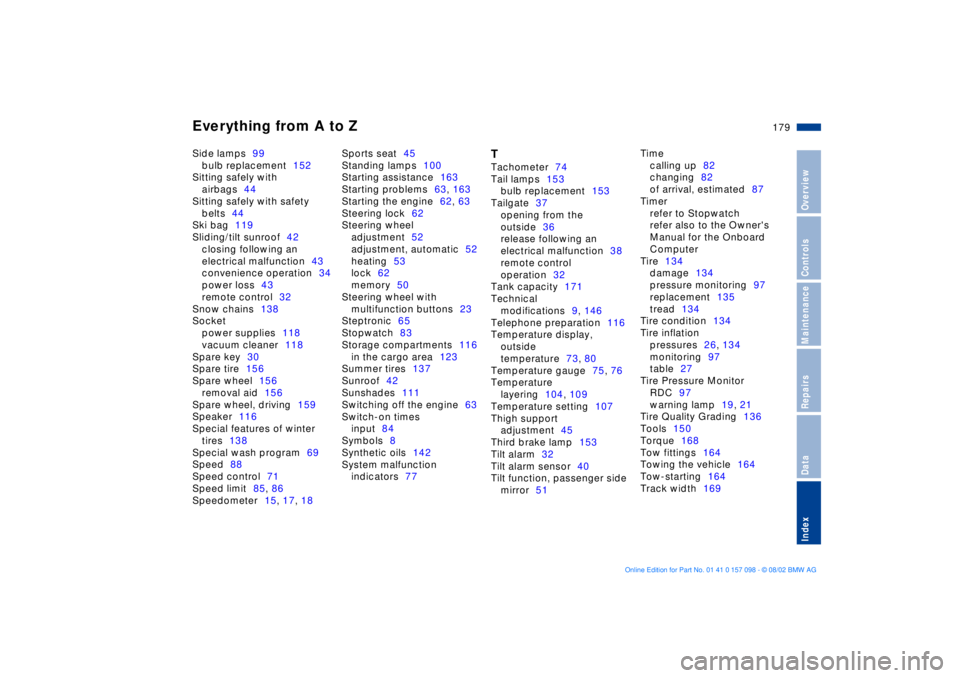
Everything from A to Z
179n
OverviewControlsMaintenanceRepairsDataIndex
Side lamps99
bulb replacement152
Sitting safely with
airbags44
Sitting safely with safety
belts44
Ski bag119
Sliding/tilt sunroof42
closing following an
electrical malfunction43
convenience operation34
power loss43
remote control32
Snow chains138
Socket
power supplies118
vacuum cleaner118
Spare key30
Spare tire156
Spare wheel156
removal aid156
Spare wheel, driving159
Speaker116
Special features of winter
tires138
Special wash program69
Speed88
Speed control71
Speed limit85, 86
Speedometer15, 17, 18Sports seat45
Standing lamps100
Starting assistance163
Starting problems63, 163
Starting the engine62, 63
Steering lock62
Steering wheel
adjustment52
adjustment, automatic52
heating53
lock62
memory50
Steering wheel with
multifunction buttons23
Steptronic65
Stopwatch83
Storage compartments116
in the cargo area123
Summer tires137
Sunroof42
Sunshades111
Switching off the engine63
Switch-on times
input84
Symbols8
Synthetic oils142
System malfunction
indicators77
TTachometer74
Tail lamps153
bulb replacement153
Tailgate37
opening from the
outside36
release following an
electrical malfunction38
remote control
operation32
Tank capacity171
Technical
modifications9, 146
Telephone preparation116
Temperature display,
outside
temperature73, 80
Temperature gauge75, 76
Temperature
layering104, 109
Temperature setting107
Thigh support
adjustment45
Third brake lamp153
Tilt alarm32
Tilt alarm sensor40
Tilt function, passenger side
mirror51Time
calling up82
changing82
of arrival, estimated87
Timer
refer to Stopwatch
refer also to the Owner's
Manual for the Onboard
Computer
Tire134
damage134
pressure monitoring97
replacement135
tread134
Tire condition134
Tire inflation
pressures26, 134
monitoring97
table27
Tire Pressure Monitor
RDC97
warning lamp19, 21
Tire Quality Grading136
Tools150
Torque168
Tow fittings164
Towing the vehicle164
Tow-starting164
Track width169